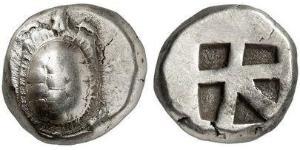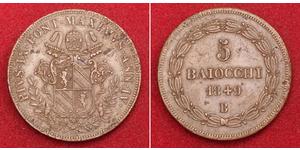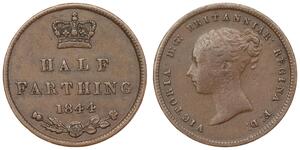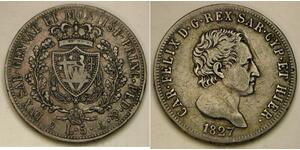1 Stater Gold
Northern Gaul, Ambiani. Rare Gold Stater “Gallic War” Coin
Region: Northeast Gaul
Mint Period: ca. 56-55 BC
Denomination: Gold Stater - Gallic War Issue!
Diameter: 17mm
Weight: 5.97gm
Material: Gold
Obverse: Devolved horse to right; pellet triad and 'charioteer’s arms' above, crescent and pellet below, exergual line with crescents and pellets below.
Reverse: Blank (as usual for this uniface issue).
The Gallic Wars were waged between 58 and 50 BC by the Roman general Julius Caesar against the peoples of Gaul (present-day France, Belgium, Germany and Switzerland). Gallic, Germanic, and British tribes fought to defend their homelands against an aggressive Roman campaign. The Wars culminated in the decisive Battle of Alesia in 52 BC, in which a complete Roman victory resulted in the expansion of the Roman Republic over the whole of Gaul. Though the Gallic military was as strong as the Romans, the Gallic tribes' internal divisions eased victory for Caesar. Gallic chieftain Vercingetorix’s attempt to unite the Gauls under a single banner came too late. Caesar portrayed the invasion as being a preemptive and defensive action, but historians agree that he fought the Wars primarily to boost his political career and to pay off his debts. Still, Gaul was of significant military importance to the Romans. Native tribes in the region, both Gallic and Germanic, had attacked Rome several times. Conquering Gaul allowed Rome to secure the natural border of the river Rhine.
The Wars began with conflict over the migration of the Helvetii in 58 BC, which drew in neighboring tribes and the Germanic Suebi. By 57 BC, Caesar had resolved to conquer all of Gaul. He led campaigns in the east, where the Nervii almost defeated him. In 56 BC, Caesar defeated the Veneti in a naval battle and took most of northwest Gaul. In 55 BC, Caesar sought to boost his public image. He undertook first-of-their-kind expeditions across the Rhine and the English Channel. Rome hailed Caesar as a hero upon his return from Britain, though he had achieved little beyond landing because his army had been too small. The next year, he returned with a proper army and conquered much of Britain. Tribes rose up on the continent, and the Romans suffered a humiliating defeat. 53 BC saw a brutal pacification campaign. This failed, and Vercingetorix led a revolt in 52 BC. Gallic forces won a notable victory at the Battle of Gergovia, but the Romans' indomitable siege works at the Battle of Alesia crushed the Gallic coalition.
In 51 BC and 50 BC, there was little resistance, and Caesar’s troops were mostly mopping up. Gaul was conquered, although it would not become a Roman province until 27 BC, and resistance would continue until as late as 70 AD. There is no clear end-date for the war, but the imminent Roman Civil War led to the withdrawal of Caesar’s troops in 50 BC. Caesar’s wild successes in the war had made him wealthy and provided a legendary reputation. The Gallic Wars were a key factor in Caesar’s ability to win the Civil War and make himself dictator, which culminated in the end of the Roman Republic and the establishment of the Roman Empire.
Julius Caesar described the Gallic Wars in his book Commentarii de Bello Gallico. It is the primary source for the conflict, but modern historians consider it prone to exaggeration. Caesar makes impossible claims about the number of Gauls killed (over a million), while claiming almost zero Roman casualties. Modern historians believe that Gallic forces were far smaller than the Romans claimed, and that the Romans suffered significant casualties. Historian David Henige regards the entire account as clever propaganda meant to boost Caesar’s image, and suggests it is of minimal historical accuracy. Regardless of the accuracy of the Commentarii, the campaign was still exceptionally brutal. Untold numbers of Gauls were killed, enslaved, or mutilated, including large numbers of civilians.
The Ambiani (Gaulish: Ambiāni, ‘those around’) were a Belgic coastal tribe dwelling in the modern Picardy region during the Iron Age and Roman periods.
They settled in the region between the 4th century and the second part of the 2nd century BC. In 113–101 BC, they took part in the fights against the Cimbri and Teutoni invaders during the Cimbrian War. In 57 and 52 BC, they participated in Gallic coalitions against Caesar, before their eventual subjugation by Rome in 51 BC. The Ambiani are known for their gold coinage, found in both northern France and Britain, which attest of extensive trading relations across the Channel.
(3205 X 1590 pixels, file size: ~749K)
Posted by: anonymous 2023-10-30
Northern Gaul, Ambiani. Rare Gold Stater "Gallic War" Coin (5.97gm) NGC XF 5/4! Region: Northeast Gaul Mint Period: ca. 56-55 BC Denomination: Gold Stater - Gallic War Issue! Condition: Certified and graded by NGC as XF (Strike 5/5, Surface 4/5). Diameter: 17mm Weight: 5.97gm ...
1/2 Farthing United Kingdom of Great Britain and Ireland (18 ...
group has 9 coins / 8 prices
⇑
5 Lira Italian city-states Silver Charles Felix of Sardinia
group has 18 coins / 16 prices
⇑









-300-150-YYnBwcI0woEAAAEnE4RaOLOG.jpg)








